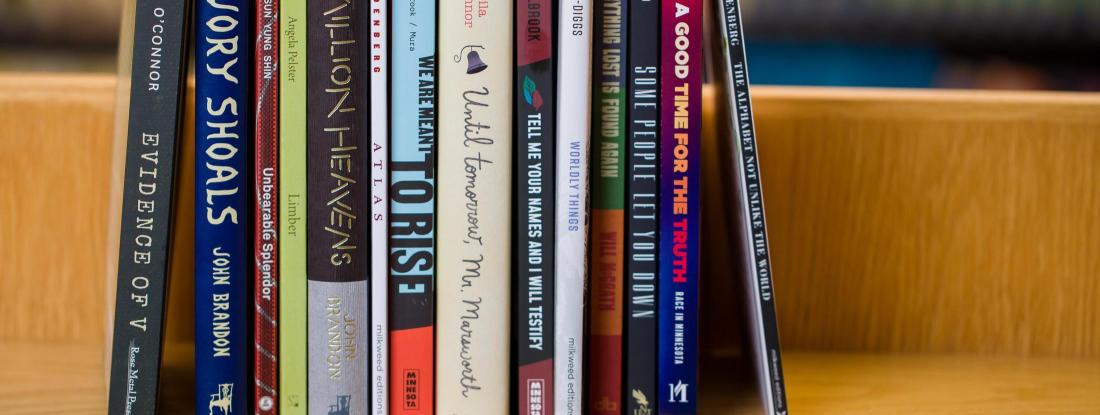Our History
The Story of Hamline's MFA in Creative Writing Program

Formation of the MFA at Hamline University
by Mary François Rockcastle, former Director, with input from Patricia Francisco, former faculty member
The current MFA in creative writing, which began in 1994, grew out of a thriving concentration in creative writing in Hamline’s Master of Arts in Liberal Studies (MALS) program. Students in the concentration, who received a MALS degree, took interdisciplinary MALS courses and creative writing courses taught by faculty in the program (e.g., Patricia Francisco, Mary Rockcastle, Deborah Keenan, Larry Sutin, Patricia Kirkpatrick, Margot Fortunato Galt, and others), all members of the vibrant Twin Cities writing community. At the time, there were no MFA programs in the state. The concentration in creative writing became so popular that the Director of GLS at the time, the writing faculty in GLS, and Quay Grigg, a professor in Hamline’s English Department, met to discuss the possible formation of an MFA.
The group agreed on an interdisciplinary approach that would include a Core Seminar, three interdisciplinary courses, three first tier writing courses, three second tier writing courses, and a Capstone, or thesis. This made Hamline unique in the world of MFA programs, at that point almost exclusively built on the workshop model.
The MFA program held classes on nights and weekends (like MALS) to accommodate the widest range of possible students. The first class, a Core Seminar taught by writer Kate Green, was entitled “Readers and Writers: Creators Both.” Afterwards, Patricia Francisco and Don Rice, a member of Hamline’s French Department, team-taught the Core Seminar for several years. Don was well-versed in literary theory while Pat Francisco focused on the creative process as it applied to writing.
In 1997 Mary Rockcastle, who taught creative writing in the MFA program, founded Water~Stone, which later became Water~Stone Review. The first issue, published in fall 1998, contained work from a national audience of writers and was meant to serve not only as a teaching tool for GLS students but as a model of the quality of literary work aspired to by faculty and students in the newly launched MFA program. DesignWorks, the graphic design studio at MCAD, helped to design the first issue and many issues afterward. A spring semester course, “Becoming an Editor: Water~Stone Review,” was created. The goal at the time was for graduate students taking the course to serve as editorial board members for that issue. The first issue was done by Rockcastle alone, with Deborah Keenan as a guest editor of poetry. Afterwards, one of the faculty poets (e.g., Deborah Keenan, Roseann Lloyd, and Patricia Kirkpatrick) co-taught the class, which was divided into groups of poetry and prose. Students read and discussed manuscripts, agreed on the contents, and worked with the faculty editors to lay out the contents. Over time, the magazine evolved, becoming larger in design, adding two spring courses instead of one, student assistant editors, writers’ interviews, writing prizes in poetry and prose, and the Meridel Le Sueur Essay, funded by Margaret Wurtele. Mary Rockcastle, who was Prose Editor for the first six issues, remained Executive Editor but Sheila O’Connor assumed the responsibilities as Prose Editor, and Patricia Kirkpatrick became the Poetry Editor. In 2008, Prose was divided into fiction and creative nonfiction, and Barrie Jean Borich joined the team as Creative Nonfiction Editor. She was followed in 2011 by Patricia Francisco, a long-time member of the program. Katrina Vandenberg, also a member of the program, took over as Poetry Editor. The Review continued to evolve and is now run by Meghan Maloney-Vinz, former managing editor of the review, with help from contributing editors.
The GLS program, which then included the MALS and MFA programs, added directed reading courses, internships in the community, sampler courses (open to students in the program and community members), and visiting writers. The two programs thrived together for many years before the MALS program was discontinued by the university in 2010.
The GLS faculty and its director, Mary Rockcastle, continued to revise the curriculum. In 2004 Rockcastle became the founding dean of the Graduate School of Liberal Studies and remained so until 2011 when the school merged with the College of Liberal Arts and Rockcastle became the Director of the Creative Writing Programs (CWP). In 2007 she founded the low-residency MFA in Writing for Children and Young Adults (MFAC), and she and the CWP faculty founded the BFA in 2011. Angela Pelster-Wiebe is now the Director of CWP and Rockcastle the Director of MFAC.
The MFA and Water~Stone Review have been long-standing programs in GLS and now CWP that have added to Hamline’s reputation for innovation and excellence. Over time, faculty retired (e.g., Sheila O’Connor, Katrina Vandenberg, Deborah Keenan, Patricia Francisco, Larry Sutin, and Julie Neraas), and new faculty were hired (e.g., John Brandon, Angela Pelster-Wiebe, Richard Pelster-Wiebe). Books were written and lives changed. We have been the luckiest of writers to work in a program of our own design, with members of the diverse writing community in the Twin Cities and beyond, and to be autonomous for so many years working with such gifted students.